Kawai CN29 User Manual
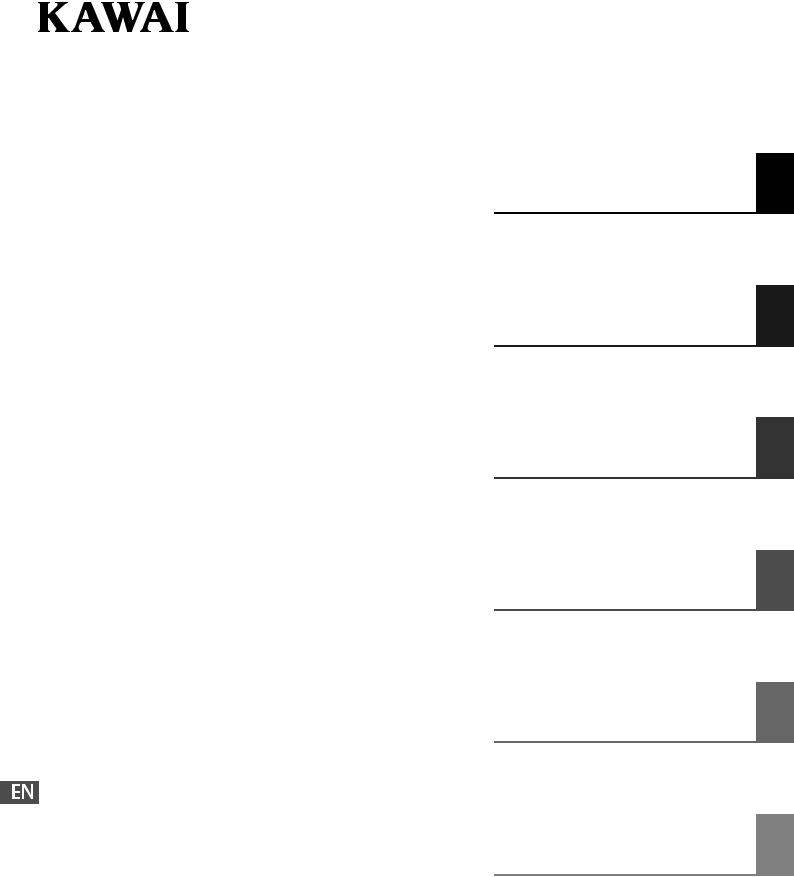
Introduction
Playing the Piano
Music Menu
CN29
Owner’s Manual
Recorder
Settings
Appendix

Thank you for purchasing this Kawai CN29 digital piano.
This owner’s manual contains important information regarding the instrument’s usage and operation. Please read all sections carefully, keeping this manual handy for future reference.
About this Owner’s Manual
Before attempting to play this instrument, please read the Introduction section from page 10 of this owner’s manual. This section explains the name and function of each part, how to connect the power cable, and how to turn on the power.
The Playing the Piano section (page 18) provides an overview of the instrument’s most commonly used functions, allowing the CN29 digital piano to be enjoyed almost immediately after being connected, while the Music Menu section (page 24) includes information regarding the built-in demonstration songs, Concert Magic songs, and Lesson function.
The Recorder section (page 34) provides instructions on how to record and play back pieces stored in the instrument’s internal memory, and the Settings section (page 37) details the settings that can be used to adjust a number of sound and keyboard characteristics, as well as system settings.
Finally, the Appendix section (page 52) includes listings for all demo, Concert Magic, and Lesson function songs, a troubleshooting guide, assembly instructions, and full specification details.
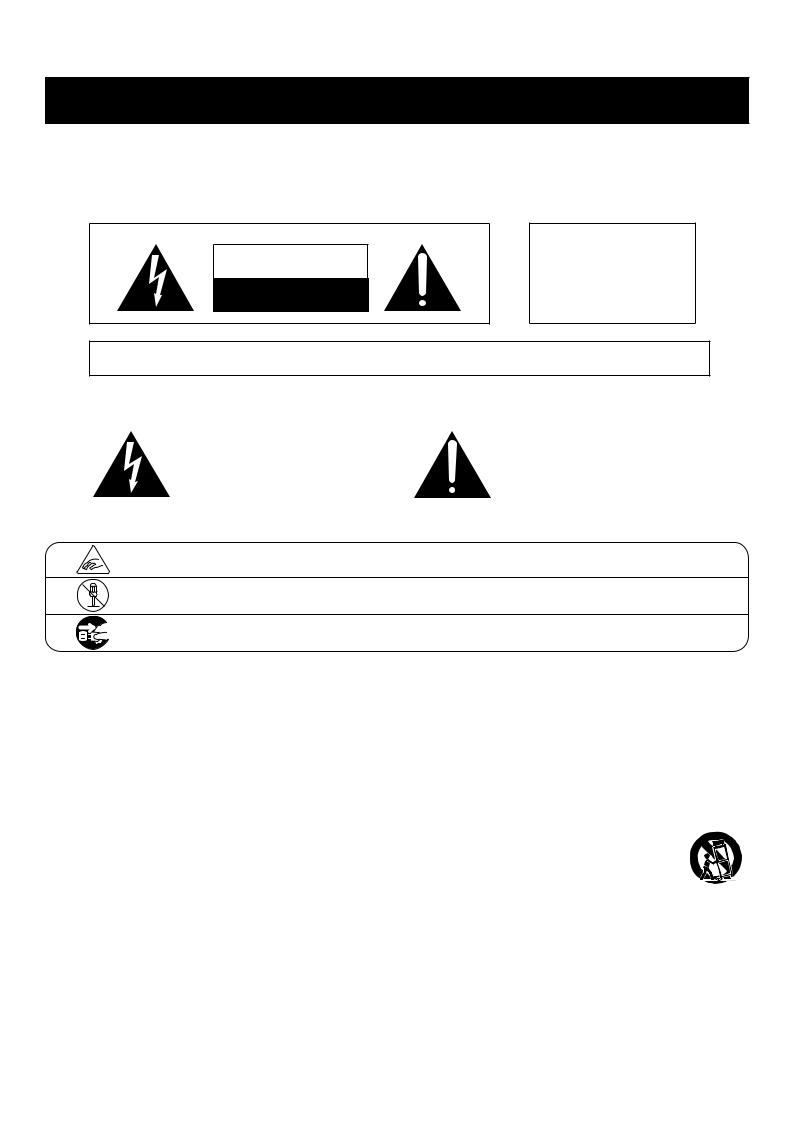
Important Safety Instructions
Important Safety Instructions
SAVE THESE INSTRUCTIONS
INSTRUCTIONS PERTAINING TO A RISK OF FIRE, ELECTRIC SHOCK, OR INJURY TO PERSONS
CAUTION |
RISK OF ELECTRIC SHOCK |
DO NOT OPEN |
WARNING
TO REDUCE THE RISK OF FIRE OR ELECTRIC SHOCK, DO NOT EXPOSE THIS PRODUCT TO RAIN OR MOISTURE.
AVIS : RISQUE DE CHOC ELECTRIQUE - NE PAS OUVRIR.
TO REDUCE THE RISK OF ELECTRIC SHOCK, DO NOT OPEN THE AC ADAPTOR.
NO USER-SERVICEABLE PARTS INSIDE. REFER SERVICING TO QUALIFIED SERVICE PERSONNEL.
The lighting ash with arrowhead symbol, within an equilateral triangle, is intended to alert the user to the presence of uninsulated "dangerous voltage" within the product's enclosure that may be of su cient magnitude to constitute a risk of electric shock to persons.
The exclamation point within an equilateral triangle is intended to alert the user to the presence of important operating and maintenance (servicing) instructions in the leterature accompanying the product.
Examples of Picture Symbols
Denotes that care should be taken.
The example instructs the user to take care not to allow ngers to be trapped.
Denotes a prohibited operation.
The example instructs that disassembly of the product is prohibited.
Denotes an operation that should be carried out.
The example instructs the user to remove the power cord plug from the AC outlet.
Read all the instructions before using the product.
1)Read these instructions.
2)Keep these instructions.
3)Heed all warnings.
4)Follow all instructions.
5)Do not use this apparatus near water.
6)Clean only with dry cloth.
7)Do not block any ventilation openings. Install in accordance with the manufacturer's instructions.
8)Do not install near any heat sources such as radiators, heat registers, stoves, or other apparatus (including amplifiers) that produce heat.
9)Do not defeat the safety purpose of the polarized or grounding-type plug. A polarized plug has two blades with one wider than the other. A grounding type plug has two blades and a third grounding prong. The wide blade or the third prongs are provided for your safety. If the provided plug does not fit into your outlet, consult an electrician for replacement of the obsolete outlet.
10)Protect the power cord from being walked on or pinched particularly at plugs, convenience receptacles, and the point where they exit from the apparatus.
11)Only use attachments/accessories specified by the manufacturer.
12)Use only with the cart, stand, tripod, bracket, or table specified by the manufacturer, or
sold with the apparatus. When a cart is used, use caution when moving the cart/apparatus combination to avoid injury from tip-over.
13)Unplug this apparatus during lightning storms or when unused for long periods of time.
14)Refer all servicing to qualified service personnel. Servicing is required when the apparatus has been damaged in any way, such as power-supply cord or plug is damaged, liquid has been spilled or objects have fallen into the apparatus, the apparatus has been exposed to rain or moisture, does not operate normally, or has been dropped.
4
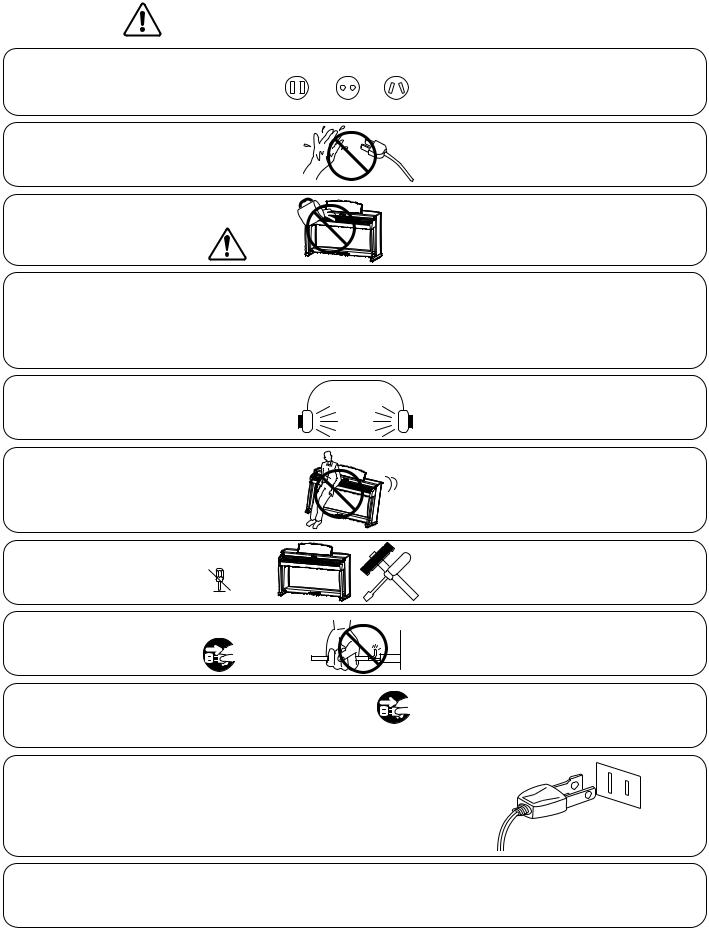
WARNING - When using electric products, basic precautions should always be followed, including the following.
|
WARNING |
Indicates a potential hazard that could result in death or |
|
||||||
|
serious injury if the product is handled incorrectly. |
|
|||||||
|
|
||||||||
The product should be connected to |
|
|
|
|
|
|
•If you are going to use an AC power cord, |
||
|
120V |
|
230V |
|
240V |
||||
an AC outlet of the speci ed voltage. |
|
|
|
|
|
|
make sure that its has the correct plug shape |
||
|
|
|
|
|
|
|
|
and conforms to the speci ed power voltage. |
|
|
|
|
|
|
|
|
|
•Failure to do so may result in re. |
|
Do not insert or disconnect the power cord plug with wet hands.
Take care not to allow any foreign matter to enter the product.
The chair must be used properly (it must be used only when playing the product).
•Do not play with it or stand on it.
•Only one person is allowed to sit on it.
•Do not sit on it when opening the lid.
•Re-tighten the bolts occasionally.
When using the headphones, do not listen for long periods of
time at high volume levels.
Do not lean against the keyboard.
Do not disassemble, repair or modify the product. 
When disconnecting the AC power cord's plug, always hold the plug
and pull it to remove it.
The product is not completely disconnected from the power supply even when the power switch is turned o . If the product will not be used for a long time, unplug the AC power cord from the AC outlet.
Doing so may cause electric shock.
Entry of water, needles or hair pins may result in breakdown or short-circuit.
The product shall not be exposed to dripping or splashing. No objects lled with liquids, such as vases, shall be placed on the product.
Doing so may cause the chair to fall over or yourngers to be trapped, resulting in injury.
Doing so may result in hearing problems.
Doing so may cause the product to fall over, resulting in injury.
Doing so may result in product breakdown, electric shock or short-circuit.
•Pulling the AC power cord itself may damage the cord, causing a re, electric shock or short-circuit.
•Failure to do so may cause re in case of lightning.
•Failure to do so may over-heat the product, resulting in re.
This product may be equipped with a polarized line plug (one blade wider than the other). This is a safety feature.
If you are unable to insert the plug into the outlet, contact an electrician to replace your obsolete outlet.
Do not defeat the safety purpose of the plug.
It is a good practice to have the instrument near the AC outlet and the power cord plug in a position so that it can readily be disconnected in an emergency because electricity is always charging while the plug is in the AC outlet even in a power switch o condition.
5
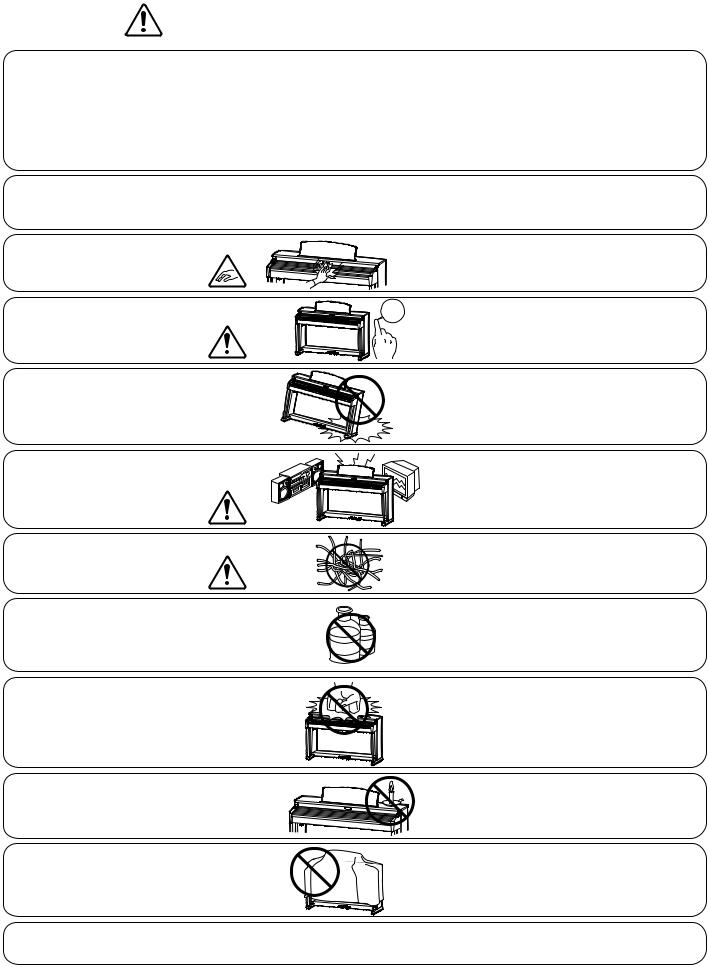
|
CAUTION |
Indicates a potential hazard that could result in injury or |
|
|
|
||
|
damage to the product or other property if the product |
|
|
|
|
is handled incorrectly. |
|
Do not use the product in the following areas.
•Areas, such as those near windows, where the product is exposed to direct sunlight
•Extremely hot areas, such as near a heater
•Extremely cold areas, such as outside
•Extremely humid areas
•Areas where a large amount of sand or dust is present
•Areas where the product is exposed to excessive vibrations
Using the product in such areas may result in product breakdown.
Use the product only in moderate climates (not in tropical climates).
Use only the AC adaptor included with this instrument to power the instrument.
•Do not use other AC adaptors to power this instrument.
•Do not use the included AC adaptor or AC power cord to power other equipment.
When you close the keyboard cover, close it gently.
Before connecting cords, make sure |
OFF |
that the power to this product |
|
and other devices is turned |
|
OFF. |
|
Closing it roughly may trap your ngers, resulting in injury.
Failure to do so may cause breakdown of this product and other devices.
Do not drag the product on the oor. Take care not to drop the product.
Do not place the product near electrical appliances such as TVs and radios.
When connecting the AC power cord and other cords, take care
not to get them tangled.
Do not wipe the product with benzene or thinner.
Do not stand on the product or exert excessive force.
Do not place naked ame, such as lighted candles on the product.
Ensure that the ventilation is not impeded by covering the ventilation openings with items, such as newspaper, table-cloths, curtains, etc.
Please lift up the product when moving it. Please note that the product is heavy and must be carried by more than two persons. Dropping the product may result in breakdown.
•Doing so may cause the product to generate noise.
•If the product generates noise, move the product su ciently away from the electrical appliance or connect it to another AC outlet.
Failure to do so may damage them, resulting inre, electric shock or short-circuit.
•Doing so may result in discoloration or deformation of the product.
•When cleaning the product, put a soft cloth in lukewarm water, squeeze it well, then wipe the product.
Doing so may cause the product to become deformed or fall over, resulting in breakdown or injury.
Doing so may cause the illumination to fall over, resulting in re.
Failure to do so may over-heat the product, resulting in re.
The product should be located so that its location or position does not interfere with its proper ventilation. Ensure a minimum distance of 5cm around the product for su cient ventilation.
6
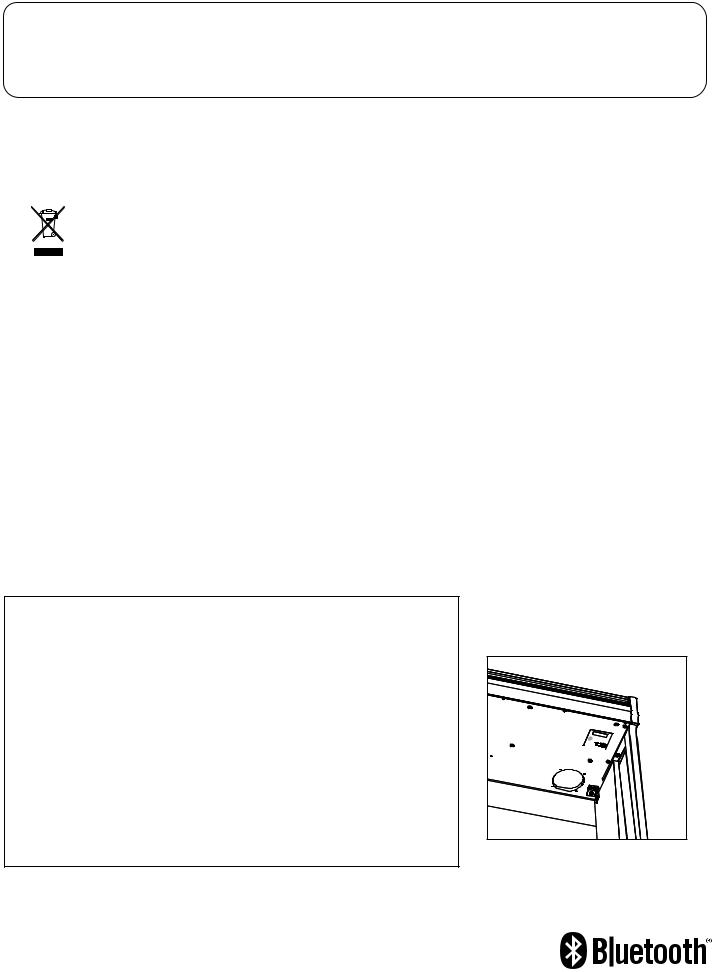
The product should be serviced by quali ed service personnel when:
•The power supply cord or the plug has been damaged.
•Objects have fallen, or liquid has been spilled into the product.
•The product has been exposed to rain.
•The product does not appear to operate normally or exhibits a marked change in performance.
•The product has been dropped, or the enclosure damaged.
Notes on Repair
Should an abnormality occur in the product, immediately turn the power OFF, disconnect the power cord plug, and then contact the shop from which the product was purchased.
CAUTION:
To prevent electric shock, match wide blade of plug to wide slot, fully insert.
ATTENTION:
Pour éviter les chocs électriques, introduire la lame la plus large de la che dans la borne correspondante de la prise et pousser jusqu'au fond.
An information on Disposal for users
If your product is marked with this recycling symbol it means that, at the end of its life, you must dispose of it separately by taking it to an
appropriate collection point.
You should not mix it with general household waste. Disposing of this product correctly will prevent potential negative e ects on the environment and human health which could otherwise arise due to inappropriate waste handling.
For further details, please contact your local authority. (European Union only)
Instruction for AC power cord (U.K.)
IMPORTANT
THE WIRES IN THIS MAINS LEAD ARE COLOURED IN ACCORDANCE WITH THE FOLLOWING CODE.
BLUE : NEUTRAL BROWN : LIVE
As the colours of the wires in the mains lead of this apparatus may not correspond with the coloured markings identifying the terminals in your plug, proceed as follows:
The wire which is coloured BLUE must be connected to the terminal which is marked with the letter N or coloured BLACK. The wire which is coloured BROWN must be connected to the terminal which is marked with the letter L or coloured RED. Do not plug either terminal of the power cord to the the ground od AC outlet on the wall.
FCC Information (U.S.A)
CAUTION : Changes or modi cations not expressly approved by the party responsible for compliance could void the user’s authority to operate the equipment.
NOTE : This equipment has been tested and found to comply with the limits for a Class B digital device, pursuant to Part 15 of the FCC Rules. These limits are designed to provide reasonable protection against harmful interference in a residential installation. This equipment generates, uses and can radiate radio frequency energy and, if not installed and used in accordance with the instructions, may cause harmful interference to radio communications. However, there is no guarantee that interference will not occur in a particular installation. If this equipment does cause harmful interference to radio or television reception, which can be determined by turning the equipment o and on, the user is encouraged to try to correct the interference by one or more of the following measures:
•Reorient or relocate the receiving antenna.
•Increase the separation between the equipment and receiver.
•Connect the equipment into an outlet on a circuit di erent from that to which the receiver is connected.
•Consult the dealer or an experienced radio/TV technician for help.
Declaration of Conformity
Products : |
Electronic Piano |
Model Number : |
CN29 |
Responsible Party Name : |
Kawai America Corporation |
Address : |
2055 East University Drive Rancho |
|
Dominguez, CA 90220 |
Telephone |
310-631-1771 |
This device complies with Part 15 of the FCC Rules.
Operation is subject to the following two conditions:
(1)this device may not cause harmful interference, and
(2)this device must accept any interference received, including interference that may cause undesired operation.
This applies only to products distributed by Kawai America Corporation.
The nameplate label is located on the underside of the instrument, as indicated below.
Nameplate 

About Bluetooth
•The Bluetooth® word mark and logos are registered trademarks owned by the Bluetooth SIG, Inc. and any use of such marks by Kawai Musical Instruments Mfg. Co., Ltd. is under license. Other trademarks and trade
names are those of their respective owners.
• Frequency Band of Radio: 2400~2483.5 MHz Maximum Transmit Power: 2.5 mW
• Availability of Bluetooth function dependent on market location.
7

Table of Contents
Important Safety Instructions. . . . . . . . . . 4
Table of Contents . . . . . . . . . . . . . . . . . 9
Introduction
Welcome to the Kawai CN29 digital piano. . 10
1. Feature Highlights. . . . . . . . . . . . . . 10
2. Owner’s Manual Conventions.. . . . . . . . . 11
Part Names and Functions. . . . . . . . . . . 12
Setting up the Piano. . . . . . . . . . . . . . . 14
1. Power.. . . . . . . . . . . . . . . . . . . . 14
2.Key cover and music rest . . . . . . . . . . . . 15
3.Volume and headphones. . . . . . . . . . . . 16
4.Pedals . . . . . . . . . . . . . . . . . . . . . 17
Playing the Piano |
|
Selecting Sounds. . . . |
. . . . . . . . . . . . 18 |
Dual Mode. . . . . . . . . . . . . . . . . . . . 19 |
|
Four Hands Mode. . |
. . . . . . . . . . . . . . 21 |
Metronome. . . . . . . . . . . . . . . . . . . .22 |
|
Music Menu
Demo Songs. . . . . . . . . . . . . . . . . . . 24
Concert Magic. . . . . . . . . . . . . . . . . . 25
Concert Magic song arrangement types. . . . . 27
Concert Magic playing mode . . . . . . . . . . .28
Concert Magic demo mode. . . . . . . . . . . .29
Lesson Function.. . . . . . . . . . . . . . . . 30
1.Selecting a lesson book and song.. . . . . . . 30
2.Listening to the selected lesson song. . . . . .32
3.Practicing left and right-hand parts separately . . 33
Recorder
Recorder. . . . . . . . . |
. . . . . |
. . . . |
. |
. |
. |
34 |
|||
1. Recording a song. . . . |
. |
. . . . |
. . . . . |
. |
|
|
|
|
34 |
2. Playing back a song. |
. |
. . |
. . . |
. |
. . . . . . 35 |
||||
3. Deleting a song. . . |
. |
. . |
. . . |
. |
. . . |
. |
. |
. |
36 |
Settings
Settings Menu.. . . . . . . . . . . . . . . . . |
|
37 |
|
1. Reverb. . . . . . . . . . . . . . . . . . . . |
|
.38 |
|
2. |
Transpose.. . . . . . . . . . . . . . . . . . |
|
39 |
3. |
Tone Control. . . . . . . . . . . . . . . . . |
|
.40 |
4. |
Dual. . . . . . . . . . . . . . . . . . . . . |
|
. 41 |
5. |
Four Hands . . . . . . . . . . . . . . . . . |
. |
41 |
6. |
Tuning. . . . . . . . . . . . . . . . . . . . |
|
. 41 |
7. Touch. . . . . . . . . . . . . . . . . . . . |
. |
42 |
|
8. |
Smart Mode Virtual Technician . . . . . . . . |
|
.43 |
9. Damper Noise.. . . . . . . . . . . . . . . . |
|
44 |
|
10. Key Volume. . . . . . . . . . . . . . . . . |
|
.45 |
|
11. Spatial Headphone Sound. . . . . . . . . . |
|
.46 |
|
12. Phones Type. . . . . . . . . . . . . . . . . 47 |
|||
13. Bluetooth MIDI.. . . . . . . . . . . . . . . |
|
48 |
|
14. MIDI Settings . . . . . . . . . . . . . . . . .49 |
|||
15. Auto Display Off. . . . . . . . . . . . . . . |
|
49 |
|
16. Auto Power Off. . . . . . . . . . . . . . . |
|
50 |
|
17. Startup Settings. . . . . . . . . . . . . . . |
|
. 51 |
|
18. Factory Reset . . . . . . . . . . . . . . . . |
|
. 51 |
|
Appendix
Connecting to Other Devices. . . . . . . . . .52
USB MIDI (USB to Host connector).. . . . . . . . . 53
Troubleshooting. . . . . . . . . . . . . . . . .54
Assembly Instructions. . . . . . . . . . . . . .55
Demo Song List . . . . . . . . . . . . . . . . . 59
Concert Magic Song List. . . . . . . . . . . . 59
Lesson Function Song Lists. . . . . . . . . . .60
Specifications. . . . . . . . . . . . . . . . . . 62
* For information regarding MIDI functions and settings, please download the supplementary PDF manual from the Kawai Global
website: http://www.kawai-global.com/support/manual
9
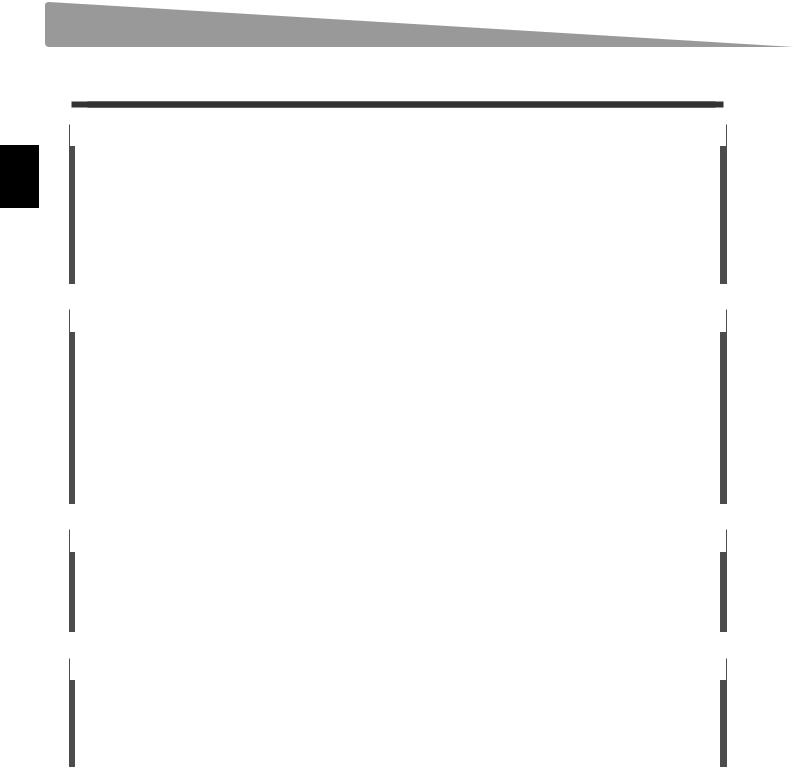
Introduction
Welcome to the Kawai CN29 digital piano
1 Feature Highlights
‘Responsive Hammer III’ weighted-key action, with Ivory Touch key surfaces and Let-off simulation
The CN29 digital piano’s Responsive Hammer III (RHIII) action recreates the distinctive touch of an acoustic grand piano, with its realistic movement and accurate 3-sensor technology providing a smooth, natural, and highly responsive piano playing experience. The weight of the keyboard is appropriately graded to mirror the heavier bass hammers and lighter treble hammers of an acoustic piano, while structural reinforcements within the action assembly ensure greater stability during fortissimo and staccato passages.
The CN29 digital piano also features Kawai’s Ivory Touch key surfaces that gently absorb finger moisture to assist the player’s performance, while, let-off simulation recreates the subtle ‘notch’ sensation felt when softly playing the keys of a grand piano, satisfying the expectations of the most discerning pianists.
Shigeru Kawai SK-EX and Kawai EX instruments reproduced with Harmonic Imaging sound technology
The CN29 digital piano captures the magnificent tone of Kawai’s flagship Shigeru Kawai SK-EX full concert grand piano. Widely regarded as the ‘premier pianos of Japan’, Shigeru Kawai instruments grace the stages of concert halls and musical institutions throughout the world, and are prized for their exceptional tonal clarity. In addition, the CN29 also features the distinctive sound of Kawai’s highly acclaimed EX concert grand piano, which has frequently been selected by professional pianists in such prestigious events as the Chopin, Tchaikovsky, and Rubinstein international piano competitions, among others.
Both instruments have been carefully recorded, meticulously analysed, and faithfully reproduced with full 88-key sampling using Harmonic Imaging™ sound technology. This unique process accurately recreates the broad dynamic range of the original grand pianos, affording pianists an extraordinary level of expressiveness ranging from the softest pianissimo to the strongest, boldest fortissimo.
Integrated Bluetooth® MIDI connectivity
In addition to standard MIDI jacks for connecting to other instruments, the CN29 digital piano also boasts integrated Bluetooth MIDI technology that allows the instrument to communicate with supported smart devices wirelessly. Once connected to a phone, tablet, or laptop, CN29 digital piano owners can enjoy a wide variety of exciting music-related apps that enhance their learning and playing experience without additional cables.
* Availability of Bluetooth function dependent on market location.
Internal Song recorder, Built-in Lesson Function
The CN29 digital piano features a three song recorder, allowing performances to be recorded to internal memory and played back at the touch of a button.
In addition, the convenient lesson feature allows aspiring pianists to learn the piano using a built-in collection of etudes from Czerny and Burgmüller, or songs from the popular Alfred course books. The left and right hand parts for each piece can be practiced separately, while adjusting the tempo allows more difficult passages to be perfected.
10

2 Owner’s Manual Conventions
This owner’s manual utilises a number of illustrative conventions in order to explain the CN29 digital piano’s various functions. The examples below provide an overview of the button LED indicator states and press types, and the appearance of difference kinds of text.
Button LED indicator states
Introduction
LED indicator off: |
LED indicator on: |
LED indicator flashing: |
Sound/Function is not selected. |
Sound/Function is selected. |
Sound/Function is selected in a |
|
|
temporary state. |
Button press types
|
× |
× |
|
2 |
4 |
Normal press: |
Press twice: |
Press multiple times: |
Select a sound or function. |
Select a sound or function. |
Cycle through sounds or settings. |
Text appearance
Normal instruction and explanation text is written in regular type at 9 pt. size.
 Captions explaining the display or button functions, are written in bold type at 8.5 pt. size.
Captions explaining the display or button functions, are written in bold type at 8.5 pt. size.
*Notes about functions are marked with an asterisk and written in 8 pt. size.
Example operations are written in italic type at 8 pt. size, and enclosed within a grey box.
Reminders about previous operations are written in italic type at 9 pt. size.
11

Part Names and Functions
Introduction
C |
|
|
D |
E |
A |
|
|
|
F |
H |
|
G |
I |
B |
|
|
|
J |
K |
|
L |
M |
N |
O |
P |
|
|
|
12
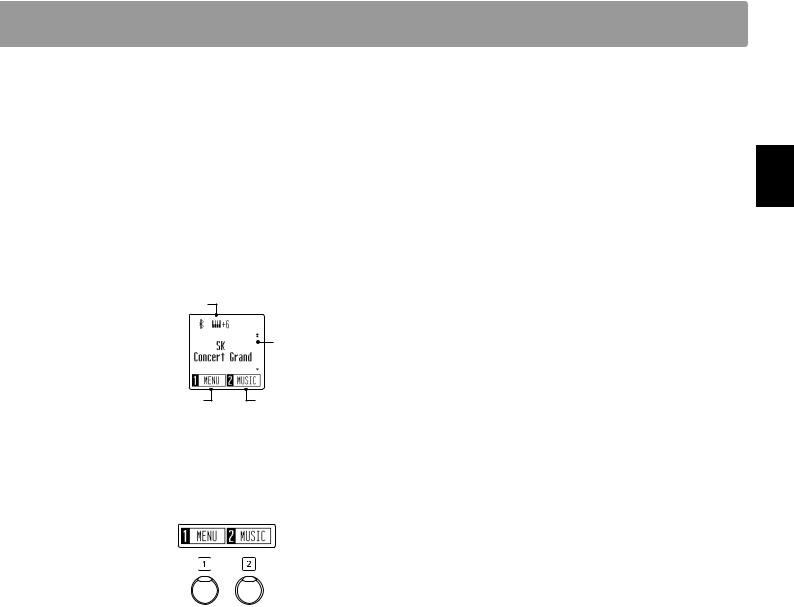
APOWER button |
HIUP / DOWN button |
This button is used to turn the CN29 digital piano on/off. |
These buttons are used cycle through sounds, navigate through |
Be sure to turn off the instrument after playing. |
menus, and adjust values. |
BMASTER VOLUME slider |
JMETRONOME button |
This slider controls the master volume level of the CN29 digital |
This button is used to turn the metronome function on/off, and |
piano’s built-in speakers or headphones, if connected. |
also to adjust its tempo, time signature, and volume settings. |
COLED Display
The OLED display provides useful information such as the currently selected sound name, settings values, and the status of other functions when active. An example of the main play screen is shown below.
Transpose status
Bluetooth  status
status
Scrollbar
Selected  sound
sound
Function #1 |
Function #2 |
*A protective plastic film is attached to the display during production. Please remove this film before attempting to play the instrument.
DEFUNCTION buttons
These buttons are used to select functions/options shown at the bottom of the display An example is shown below.
KSOUND SELECT button
This button is used to select the sound(s) that will be heard when the keys are pressed.
Pressing both the [METRONOME] and [SOUND SELECT] buttons simultaneously will activate DUAL mode, allowing two different voices to be played together.
LPEDAL connector
This connector is used to connect the CN29 digital piano’s pedal board to the instrument.
MDC IN jack
This jack is used to connect the AC adaptor.
NUSB to Host port
This port is use to connect the instrument to a computer using a USB ‘B to A’ type cable in order to send and receive MIDI data.
OMIDI IN / OUT jacks
These jacks are used to connect the CN29 digital piano to external MIDI devices, such as other musical instruments or a computer, in order to send and receive MIDI data.
FREC button
This button is used to record performances to the CN29 digital piano’s internal memory.
GPLAY / STOP button
This button is used to start/stop the playback of Recorder songs stored in memory and CN29 digital piano’s built-in Lessons songs.
PPHONES jacks
These jacks are used to connect stereo headphones to the CN29 digital piano. 1/4” and 1/8” connectors are provided for convenience, and both can be used simultaneously, allowing two pairs of headphones to be connected at the same time.
Introduction
13
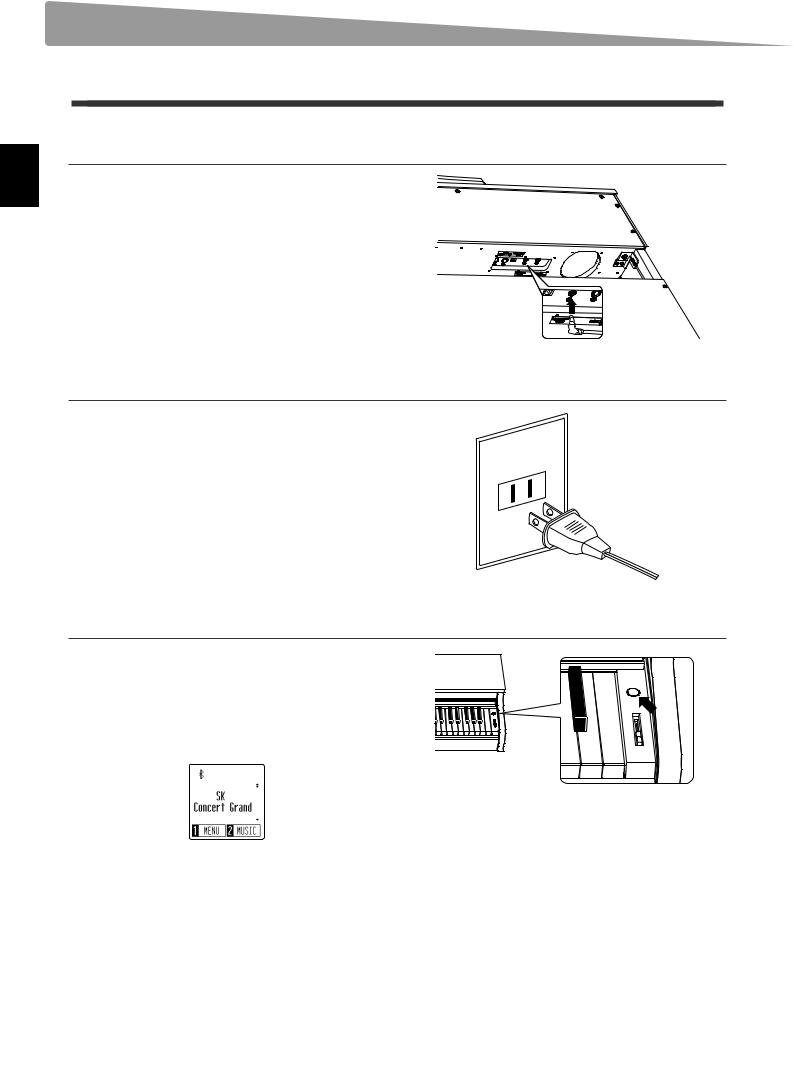
Setting up the Piano
1 Power
1. Connecting the power adaptor to the instrument
Connect the AC power adaptor to the DC IN terminal located on the underside of the instrument, as indicated below.
Introduction
2. Connecting the power adaptor to an outlet
Connect the AC power adaptor to an AC outlet.
3. Turning on the power
Press the POWER button, located on the right hand side of the instrument’s front panel.
The instrument will turn on, and the words ‘SK Concert Grand’ will be shown in the display, indicating that the SK Concert Grand sound is selected, and the instrument is ready to be played.
*The CN29 digital piano incorporates power saving features that can turn off the display and the instrument automatically after a specified period of inactivity. For more information, please refer to the ‘Auto Display Off’ and ‘Auto Power Off’ settings on pages 49 and 50.
14

2 Key cover and music rest
Opening the key cover
Gently lift the key cover with both hands, then slowly push it back, into the instrument’s body. To close the key cover, slowly pull the handle with both hands, then gently lower it downward.
* Please close the lid slowly in order to avoid injury.
Adjusting the music rest
Lift the music rest, then lower the metal prop (rear side) into the recessed holder to set the desired music rest angle.
* The music rest can be set to one of three different angle positions.
Prop and holder |
To lower the music rest, gently lift the prop from the recessed holder, then lower the music rest.
* Please lower the music rest slowly in order to avoid injury.
Introduction
15
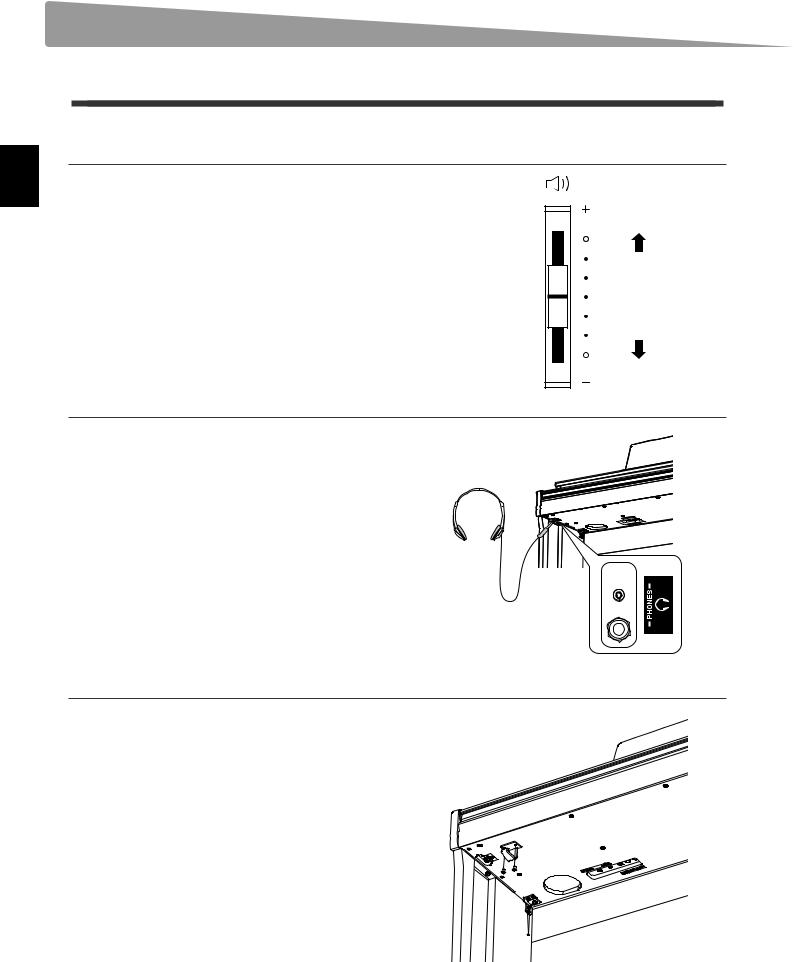
Introduction
Setting up the Piano
3 Volume and headphones
Adjusting the volume
The [MASTER VOLUME] slider controls the volume level of the instrument’s speakers, or headphones if connected.
Move the slider up to increase the volume, and down to decrease the volume.
Use this slider to set the volume to a comfortable listening level
– the middle is often a good starting point.
Using headphones
Use the jacks located beneath the keyboard on the left hand side, to connect stereo headphones to the CN29 digital piano. 1/4” and 1/8” connectors are provided for convenience.
Two pairs of headphones can be connected and used simultaneously.
Attaching the headphone hook (optional)
A headphone hook is included with the CN29 digital piano and can be used to hang headphones when not in use.
If desired, attach the headphone hook to the underside of the keyboard as shown in the illustration opposite.
*For more information, please refer to the ‘Assembly Instructions’ on page 58
Increase
volume
Decrease
volume
16

4 Pedals
As with a grand piano, the CN29 digital piano features three pedals: sustain, sostenuto, and soft.
Sustain pedal (right pedal)
Depressing this pedal sustains the sound after one’s hands have been lifted from the keyboard – greatly enriching the piano sound, while also assisting smooth ‘legato’ passages.
Soft pedal 
The sustain pedal is capable of responding to half pedaling.
Sostenuto pedal
Sustain pedal 
Soft pedal (left pedal)
Depressing this pedal softens the sound, reducing its volume.
When the Jazz Organ sound is selected, the soft pedal is also used to alternate the speed of the rotary simulation between ‘Slow’ and ‘Fast’ effect modes.
Sostenuto pedal (centre pedal)
Depressing this pedal after playing the keyboard and before releasing the keys, sustains the sound of only those notes that have been played. Any keys that are subsequently played after the sostenuto pedal is depressed will not be sustained.
Pedal support bolt
A pedal support bolt is attached at the base of the pedal board to aid stability when the pedals are pushed.
Turn the bolt anti-clockwise until it makes contact with the floor and supports the pedals firmly. If the pedal support bolt does not make contact with the floor, the pedal board may become
damaged. |
Pedal support bolt |
|
When moving the instrument, always adjust or remove the pedal support bolt, then readjust when the instrument is in its new position.
Caring for the pedals
If the surface of the pedals becomes dirty, clean the pedals using a dry dish-washing sponge.
Do not attempt to clean the pedals using rust-removing solvents, abrasives or files.
Grand Feel Pedal System
The CN29 digital piano features the Grand Feel Pedal System, which replicates the sustain, soft, and sostenuto pedal weighting of a Shigeru Kawai SK Concert Grand piano.
Introduction
17
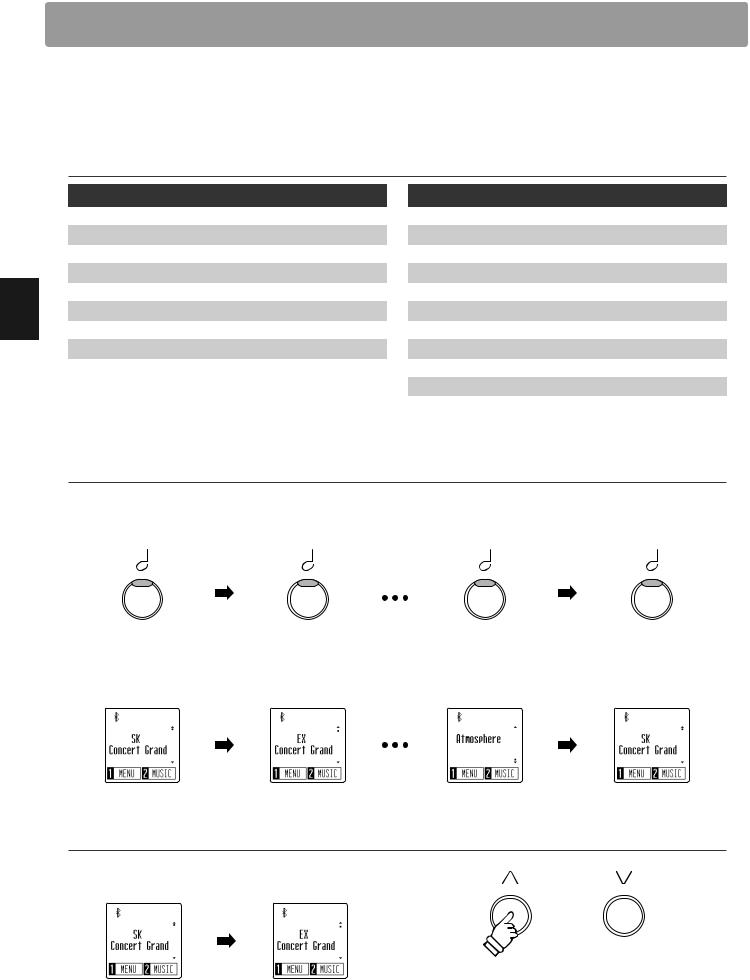
Playing the Piano
Selecting Sounds
The CN29 digital piano features 19 different instrument sounds, which can be selected in one of two ways. By default the ‘SK Concert Grand’ sound will be selected automatically when the instrument is turned on.
Available sounds
Acoustic piano sound |
Other sounds |
SK Concert Grand |
Classic E.Piano |
EX Concert Grand |
Modern E.Piano |
Upright Piano |
Jazz Organ |
Studio Grand |
Church Organ |
Studio Grand 2 |
Harpsichord |
Mellow Grand |
Vibraphone |
Mellow Grand 2 |
String Ensemble |
Modern Piano |
Slow Strings |
|
Choir |
|
New Age Pad |
|
Atmosphere |
Selecting a sound: Method 1
Press the [SOUND SELECT] button repeatedly to cycle through the 19 available instrument sounds.
[Power On]
Press once |
Press 17 times |
Press once |
SK Concert Grand |
EX Concert Grand |
Atmosphere |
SK Concert Grand |
The name of the selected sound will be shown in the display:
Selecting a sound: Method 2
Press the [UP] or [DOWN] buttons to cycle through the 19 available instrument sounds.
or
* The preferred sound can be stored to the Startup Setting memory for automatic selection when the instrument is turned on. Please refer to
page 51 for more information.
18

Dual Mode
The Dual Mode function allows two sounds to be layered together, creating a more complex sound. For example, a piano sound layered with strings, or an electric piano combined with a harpsichord etc.
Entering Dual Mode
While the normal playing screen is shown in the display:
Press the [METRONOME] and [SOUND SELECT] buttons simultaneously to enable Dual Mode.
The Dual screen will be shown in the display, with the names of the main and layered sounds indicated.
Main sound |
|
|
|
|
* When Dual Mode is enabled, the Slow Strings sound will automatically |
|
|
|
|
||
(selected) |
|
|
|
Layered sound |
|
|
|
|
|||
|
|
|
|
|
be selected as the layered sound. |
Changing the main/layered sounds
While Dual Mode is enabled:
Press the [SOUND SELECT] button to move the selection cursor over the main or layered sound.
Press the [UP] or [DOWN] buttons to change the assigned sound. |
or |
*The preferred Dual Mode sound combination can be stored to the Startup Setting memory for automatic selection when the instrument is turned on. Please refer to page 51 for more information.
Adjusting the main/layered sound volume balance
Continued overleaf.
Playing the Piano
19
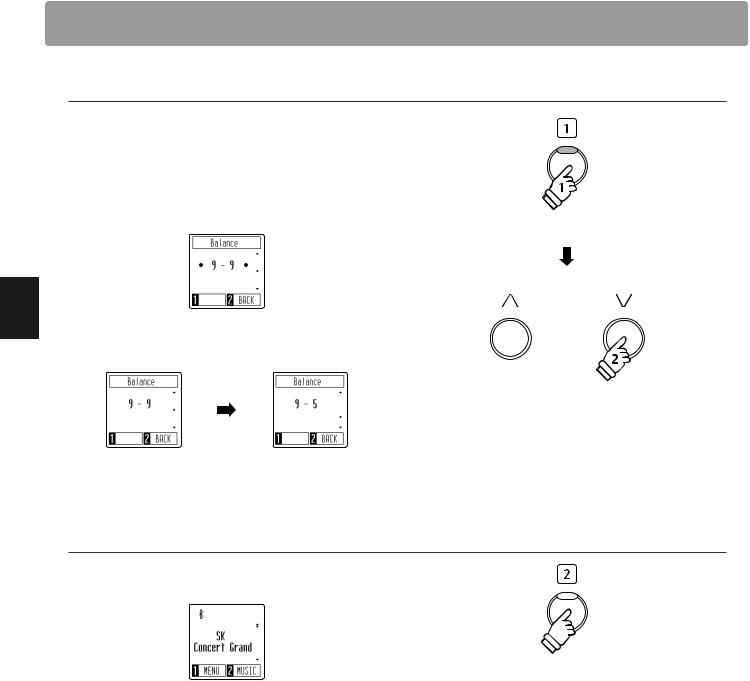
Playing the Piano
Dual Mode
Adjusting the main/layered sound volume balance
While Dual Mode is enabled:
Press the [1] function button (EDIT) to show the Dual Mode edit screen.
The right number represents the main sound volume, while the left number represents the layered sound volume.
Layered sound |
|
|
|
Main sound |
volume |
|
|
|
volume |
Press the [UP] or [DOWN] buttons to change the volume balance |
or |
between the main and layered sounds. |
|
* To reset the Dual Mode volume balance to the default value, press the |
* The preferred Dual Mode volume balance can be stored to the Startup |
[UP] and [DOWN] buttons simultaneously. |
Setting memory for automatic selection when the instrument is |
|
turned on. Please refer to page 51 for more information. |
Exiting Dual Mode
Press the [2] function button (BACK) to exit Dual Mode and return to normal operation.
20
